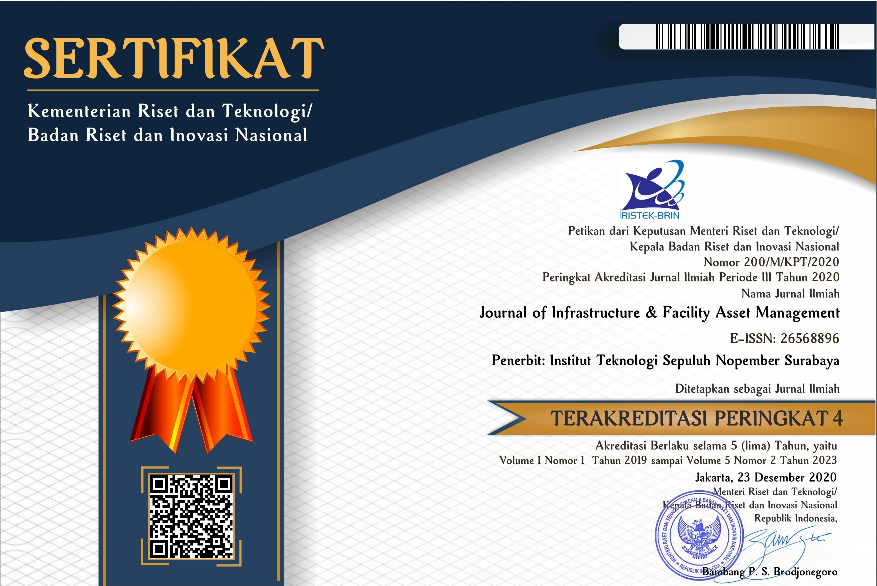Evaluation of Smart Mobility Indicators in Responding COVID-19 Pandemic in Indonesia
Abstract
The COVID-19 outbreak cuts the number of trips and people’s movement during the day. Not only because of the community’s awareness for the disease transmission but also because of the enforcement from the government to apply the mobility policy. This changing trip behavior is predicted to happen throughout the time of pandemic and post-pandemic. On the contrary, when mobility is decreasing, the role of ICT in community activities is increasing. This condition leads to an interesting question for the smart city, especially the smart mobility concept, whether the smart mobility concept has been properly addressed and responded to the pandemic and post-pandemic era or not. This paper aims to explore how far smart mobility planning has been applied by local governments in Indonesia, especially in response to community activity during the pandemic era. Our approach in this paper is a qualitative study in evaluating online local government planning documents as our main data. We choose the study cases in three cities that got high tier ranks in the smart city awards in 2019 (based on Rating Kota Cerdas Indonesia/Indonesia’s Smart Cities Rating), which are Semarang, Samarinda, Magelang. We review literature on smart mobility indicators and those smart mobility indicators used in planning documents. Then, we evaluate the relevance of those indicators to the condition of pandemic and post pandemic era. We found that smart mobility indicators have not been received much concern as the main aspect of smart city in Indonesia.
Full Text:
PDFReferences
Abu-Rayash, A., & Dincer, I. (2020). “Analysis of mobility trends during the COVID-19 coronavirus pandemic: Exploring the impacts on global aviation and travel in selected cities”. Energy Research & Social Science, 68, Article 101693. https://doi.org/ 10.1016/j.erss.2020.101693
Ahvenniemi, H., Huovila, A., Pinto-Seppä, I., & Airaksinen, M. (2017). “What are the differences between sustainable and smart cities?”. Cities, 60, 234–245. https://doi.org/10.1016/j.cities.2016.09.009
Albino, V., Berardi, U., & Dangelico, R. M. (2015). “Smart Cities: Definitions, Dimensions, Performance, and Initiatives”. Journal of Urban Technology. 22(1), 3–21. https://doi.org/10.1080/10630732.2014.942092
Battarra, R., Gargiulo, C., Tremiterra, M. R., & Zucaro, F. (2018). “Smart mobility in Italian metropolitan cities: A comparative analysis through indicators and actions”. Sustainable Cities and Society, 41, 556–567. https://doi.org/10.1016/j.scs.2018.06.006
Benevolo, C., Dameri, R.P., D’Auria, B. (2016). “Smart mobility in smart city. In Empowering Organizations”. Springer: Berlin/Heidelberg, Germany, 2016; pp. 13–28. Germany.
Beria, P., & Lunkar, V. (2021). “Presence and mobility of the population during the first wave of COVID-19 outbreak and lockdown in Italy”. Sustainable Cities and Society, 65, Article 102616. https://doi.org/10.1016/j.scs.2020.102616
Bucsky, P. (2020). “Modal share changes due to COVID-19: The case of Budapest”. Transportation Research Interdisciplinary Perspectives, 8, Article 100141. https://doi.org/10.1016/j.trip.2020.100141
Buehler, R., & Pucher, J. (2021). “COVID-19 impacts on cycling, 2019–2020”. Transport Reviews, 41(4), 393–400. https://doi.org/10.1080/01441647.2021.1914900
Chen, Y., & Silva, E. A. (2021). “Smart transport: A comparative analysis using the most used indicators in the literature juxtaposed with interventions in English metropolitan areas”. Transportation Research Interdisciplinary Perspectives, 10, 100371. https://doi.org/10.1016/j.trip.2021.100371
Debnath, A. K., Chin, H. C., Haque, Md. M., & Yuen, B. (2014). “A methodological framework for benchmarking smart transport cities”. Cities, 37, 47–56. https://doi.org/10.1016/j.cities.2013.11.004
Deloitte (2015). “Smart Mobility: Commuting in the Digital Age”. Available online:https://www2.deloitte.com/insights/us/en/focus/future-of-mobility/smart-mobility-trends-transportation-on-demand.html (accessed on 4 September 2019).
Dia, H. (2016). “The real-time city: Unlocking the potential of smart mobility”. In Proceedings of the 38th Australasian Transport Research Forum (ATRF 2016), 16–18 November 2016. Melbourne, Australia.
De Vos, J. (2020). “The effect of COVID-19 and subsequent social distancing on travel behavior”. Transportation Research Interdisciplinary Perspectives, 5, Article 100121. https://doi.org/10.1016/j.trip.2020.100121
Garau, C., Masala, F., & Pinna, F. (2015). “Benchmarking Smart Urban Mobility: A Study on Italian Cities. In O. Gervasi, B. Murgante, S. Misra, M. L. Gavrilova, A. M. A. C. Rocha, C. Torre, [15] D. Taniar, & B. O. Apduhan (Eds.), Computational Science and Its Applications—ICCSA 2015 (Vol. 9156, pp. 612–623)”. Springer International Publishing. https://doi.org/10.1007/978-3-319-21407-8_43
Giffinger, R., & Pichler-Milanović, N. (2007). Smart cities: Ranking of European medium-sized cities. Centre of Regional Science, Vienna University of Technology.
Giuliano, G. & Hanson, S. (2017). Looking to the future. The geography of urban transportation, 359-388.
International Transport Forum (2020). Re-spacing Our Cities For Resilience. Organisation for Economic Co-operation and Development. https://www.itf-oecd.org/sites/default/files/respacing-cities-resilience-covid-19.pdf
Kitchin, R., Lauriault, T. P., & McArdle, G. (2015). “Knowing and governing cities through urban indicators, city benchmarking and real-time dashboards”. Regional Studies, Regional Science, 2(1), 6–28. https://doi.org/10.1080/21681376.2014.983149
Lyons, G., Jain, J., Mitchell, V., May, A (2012). The Emergent Role of User Innovation in Reshaping Traveler Information Services. Routledge: New York, NY, USA.
Mahesa, R., Yudoko, G., & Anggoro, Y. (2019). “Dataset on the sustainable smart city development in Indonesia”. Data in Brief, 25, 104098. https://doi.org/10.1016/j.dib.2019.104098
Magelang City Mayor Regulation Number 26 Tahun 2018 on Masterplan of Magelang Smart City
Mouratidis, K., & Papagiannakis, A. (2021). “COVID-19, internet, and mobility: The rise of telework, telehealth, e-learning, and e-shopping”. Sustainable Cities and Society, 74, 103182. https://doi.org/10.1016/j.scs.2021.103182
Shakibaei, S., de Jong, G. C., Alpkokin, P., & Rashidi, T. H. (2021). “Impact of the COVID-19 pandemic on travel behavior in Istanbul: A panel data analysis”. Sustainable Cities and Society, 65, Article 102619. https://doi.org/10.1016/j.scs.2020.102619
Pindarwati, A., & Wijayanto, A. W. (2015). “Measuring performance level of smart transportation system in big cities of Indonesia comparative study: Jakarta, Bandung, Medan, Surabaya, and Makassar”. 2015 International Conference on Information Technology Systems and Innovation (ICITSI), 1–6. https://doi.org/10.1109/ICITSI.2015.7437716
Samarinda City Mayor Regulation Number 8 Year 2018 on Masterplan of Samarinda Smart City
Semarang City Mayor Regulation Number 26 Year 2018 on Masterplan of Semarang Smart City
So, J. (Jason), An, H., & Lee, C. (2020). “Defining Smart Mobility Service Levels via Text Mining”. Sustainability, 12(21), 9293. https://doi.org/10.3390/su12219293
DOI: http://dx.doi.org/10.12962%2Fjifam.v4i2.14370
Refbacks
- There are currently no refbacks.
Visitor :
Flag Counter

Journal Of Infrastructure & Facility Asset Management by Institut Teknologi Sepuluh Nopember is licensed under a Creative Commons Attribution-ShareAlike 4.0 International License.





